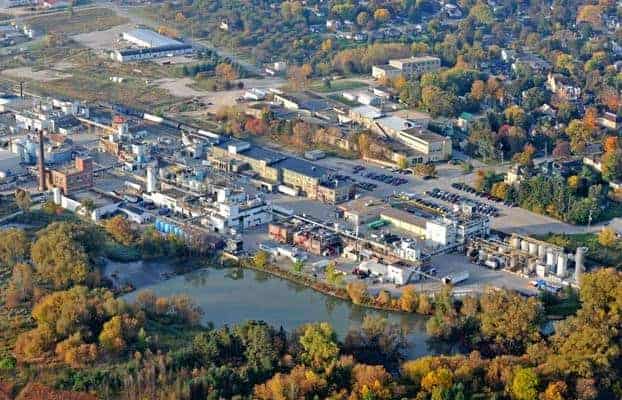ELMIRA — This month marks 31 years since the town’s residents were told they must not drink their own water.
NDMA or nitrosodimethylamine, a chemical known to cause cancer, liver and lung damage, and death in test animals, was detected in extremely high amounts in Elmira’s aquifer in November 1989.
The town’s water was shut off and citizens subsisted on bottled water until a pipeline to Waterloo’s aquifer was built. This is still the source of Elmira’s tap water.
Since then, the aquifer has been undergoing treatment, but the status of the cleanup remains murky.
Some background
The story begins in an old brick factory building, within short walking distance from Elmira’s downtown core. It’s now on property owned by Lanxess Canada.
The building was first owned by the Elmira Felt Company, producing shoes in the late 1890s and early 1900s. Production stopped because of the Great Depression in the 1930s.
Eventually, Naugatuck Chemicals took over in 1941 to make chemicals for explosives during the Second World War. When the war was over, the company switched to making pesticides, insecticides and fungicides including the infamous dichloro-diphenyl-trichloroethane, known as DDT.
From the 1940s until the late 1960s, toxic waste from making chemicals like DDT, and Agent Orange — a combination of 2,4-D (2,4-Dichlorophenoxyacetic acid) and 2,4,5-T (2,4,5-Trichlorophenoxyacetic acid) — was dumped in open, overflowing lagoons, buried in drums that eventually corroded and leaked chemicals into the ground, burned in open pits or drained directly into the creek with little treatment.
The site was owned by a series of companies including Uniroyal in 1966, Crompton and Knowles in 1996, then Crompton in 2000 and Chemtura in 2005. Lanxess bought the Chemtura Chemical Company in 2017, and this included 20 locations in 11 countries, including the Elmira site, said Jamie Petznick, Lanxess health and safety environmental manager.
In 1989 the Ministry of Environment checked the groundwater in Elmira and detected high levels of NDMA in the aquifer.
The following month, a special report was delivered to the Region of Waterloo about the contamination levels of NDMA in Elmira’s drinking water.
Elmira’s groundwater NDMA levels ranged from 1200 to 2900 parts per trillion, or ppt.
At the time, Ontario did not have a standard acceptable level of NDMA but shortly after implemented a guideline of 13 ppt. Today the provincial standard is 9 ppt.
The wells were shut down and the town subsisted off bottled water until a pipe was built to bring in water from Waterloo’s aquifer, where the town still gets its water today.
Current Status
Current owner Lanxess is a German company that manufactures synthetic rubber lubricants, and additives for lubricants, plastics and rubber, from its Elmira plant. In addition to the main production facilities, it houses a comprehensive wastewater treatment system that is used to treat all of the process wastewater that is generated on-site, and “a groundwater treatment system to remove historic contaminants prior to discharge,” its website says.
The cleanup of Elmira’s water has two main aspects: pumping the NDMA-laced water out of the aquifer and also cleaning the contaminants out of Canagagigue Creek, which runs through the Lanxess property and was historically used to dispose of wastes directly by chemical companies at that site and other industries in Elmira.
The Aquifer
NDMA is found as a byproduct in many everyday products like cured meats and fish, cheese, beer, tobacco, shampoo, cleansers and detergents. Last year it was found in higher than safe concentrations in heartburn medications that caused the United States Food and Drug Administration to issue recalls.
But how did the NDMA get into the aquifer in the first place?
NDMA is not a manufactured product, but a chemical that formed at the site when two other process wastes, amine and sodium nitrite, were mixed, says Petznick.
Before regulations for chemical waste disposal were developed, the chemical companies operating at this site dumped these two substances into the same lagoons and the resulting NDMA seeped its way into Elmira’s groundwater.
The province ordered Uniroyal to pump and treat water in the part of the aquifer under the town to clean out the contamination, as well as pump the part of the aquifer directly under the Uniroyal site to prevent further spread of contamination coming from the site. These were two actions among others, such as removing some of the buried waste at the site. As more was learned about the contamination and how to clean it, the province chose 2028 as the deadline to clean Elmira’s aquifer to drinking-water standards.
The obligation to follow this order was passed onto every incoming company that took over the site.
So where are we today?
Since then, pumps have been working practically non-stop moving contaminated water from Elmira’s aquifer to the water treatment facility at the Lanxess property.
The water is put through various methods to clean it including carbon filtration, UV light and oxidation to break down organic compounds (including NDMA), bacterial digestion to remove ammonia and a polishing stage with sand particles. The final product meets Ontario drinking water standards, and is then discharged into the Canagagigue Creek.
Today, Lanxess estimates that approximately 95 per cent of the NDMA has been cleaned out of the aquifer. By 2028, Lanxess estimates over 99 per cent of the NDMA will be cleaned out of the aquifer, but it will not meet the Ministry of Environment’s requirement to bring the aquifer to drinking water standards.
“We do not feel that the 2028 target will be met, due to a variety of factors, such as available technical capabilities, the low Ontario cleanup standard, the aquifer flow characteristics, and the various ways cleanup may be evaluated and defined,” Lanxess states on its website.
“We are at a point in the remediation where there is no known scientifically available methodology to remove that last bit of contaminant from such a massive aquifer.”
Ramin Ansari is the corporate manager of environmental affairs and remediation at Lanxess.
“Groundwater cleanup takes decades,” he said. “Ten years of contamination can take 20 or 30 years to remediate.”
“We are not going to meet that deadline. That was an arbitrary timeline that was set.”
The Ministry of Environment, Conservation and Parks also acknowledges that the deadline will most likely not be met.
“Lanxess is required to meet the terms of the ministry order for the cleanup of the municipal aquifers in Elmira,” says Gary Wheeler, a spokesperson for the ministry.
“Significant progress has been made in the remediation of the municipal aquifer and environmental monitoring is showing decreasing trends of contamination. However, computer modelling has indicated that the current groundwater treatment technology may not completely remediate the entire off-site municipal aquifer to the Ontario Drinking Water Standards by 2028.”
“The ministry is working to ensure Lanxess continues to evaluate alternative remedial technologies available today and in the future to continue progress on remediation of the municipal aquifer.”
Tiffany Svensson is the chair of the Technical Advisory Group. This committee of experts looks over Lanxess reports, and keeps abreast of the situation. They advise the Remediation Advisory Committee, which is a group of citizens that gives independent public input into the remediation process and reports to township council.
Svensson says she also believes Elmira’s aquifer will not meet drinking water standards by the 2028 deadline. The provincial order to Lanxess will also end that year and will need to be replaced.
Svensson says the community must begin deciding its priorities when it comes to water. She says this matter-of-factly.
“Leading up to 2028, there’s going to need to be a process. We need to start talking about the future [provincial] order. Exactly how does that look? The next three years will be important.”
“If you were living in Elmira, what would you want to see as a standard of cleanup?”
Leah Gerber’s reporting is funded by the Canadian government through its Local Journalism Initiative. The funding allows her to report on stories about the Grand River Watershed. This story was originally published in The Record.









